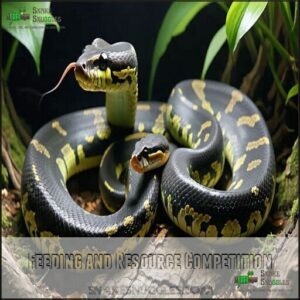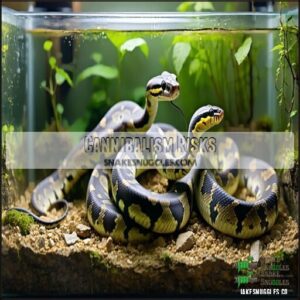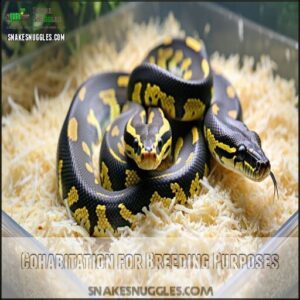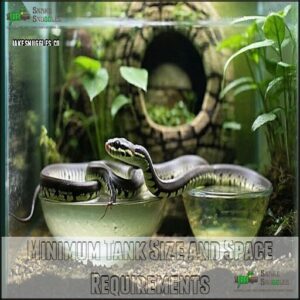This site is supported by our readers. We may earn a commission, at no cost to you, if you purchase through links.

These snakes are naturally solitary and get stressed when forced to share space. Cohabitation can lead to fights, dominance issues, and even serious health problems like disease transmission or injury.
Feeding time gets tricky too—one snake might hog the meal while the other goes hungry. Plus, stress from cohabitation weakens their immune system, making them more susceptible to illness.
Sure, they might “tolerate” each other for a bit, but it’s like sharing a room with someone who steals your snacks—problems are bound to happen. A separate enclosure guarantees happier, healthier snakes!
Table Of Contents
- Key Takeaways
- Ball Pythons Living Together
- Can Two Ball Pythons Live Together
- Dangers of Housing Two Ball Pythons Together
- Cohabitation Risks and Health Problems
- Safe Housing Practices for Multiple Ball Pythons
- Cohabitation for Breeding Purposes
- Consequences of Cohabitation
- Benefits of Separate Housing for Ball Pythons
- Safe Cohabitation Options and Precautions
- Ideal Setup for Housing Ball Pythons
- Frequently Asked Questions (FAQs)
- How much space do you need for a ball python?
- Can You house two ball pythons together?
- Do ball pythons live together?
- What happens if two ball pythons are still cohabiting?
- Do ball pythons copulate?
- Can you put two ball pythons in the same tank?
- Can you keep two ball pythons in one tank?
- Can ball pythons live in pairs?
- Can 2 snakes live in the same tank?
- What size tank for 2 ball pythons?
- Conclusion
Key Takeaways
- Snakes are solitary and don’t enjoy sharing space, so house them separately to avoid stress and aggression.
- Cohabitation risks include dominance, fights, and even cannibalism, which harm their health and well-being.
- Sharing resources like hides and basking spots causes competition, leading to stress and illness.
- Separate enclosures guarantee proper care, feeding, and stress-free living for healthier, happier snakes.
Ball Pythons Living Together
You’ll rarely see ball pythons hanging out together in the wild because they’re naturally solitary creatures who only meet up for breeding purposes.
When you force two ball pythons to share the same space in captivity, you’re setting them up for stress, competition, and potential health problems that wouldn’t occur if they lived separately.
Ball Pythons in The Wild
In the wild, ball pythons lead distinctly solitary lives – a fact often overlooked by new owners.
These natural introverts roam African savannas independently, with interactions limited to breeding season.
Wild ball pythons demonstrate classic solitary behavior through:
- Establishing personal territories in abandoned rodent burrows and termite mounds
- Meeting other pythons primarily for brief mating encounters before separating
- Dispersing as hatchlings immediately after emerging from eggs
You’ll rarely spot two wild pythons sharing space voluntarily.
This natural tendency toward isolation isn’t antisocial – it’s a survival strategy honed over thousands of years, helping them secure food sources and avoid predation.
Ball Pythons as Solitary Creatures
A single ball python thrives best when living alone – it’s simply in their DNA.
These reptiles aren’t wired for companionship like dogs or cats. Their solitary instincts developed from millions of years evolving as independent hunters in their natural habitat.
| Characteristic | Wild Ball Python | Captive Ball Python |
|---|---|---|
| Social Needs | None – completely solitary | None – prefers isolation |
| Stress Triggers | Predators, weather | Other snakes in enclosure |
| Territory | Large, self-chosen | Limited to provided space |
| Interaction Style | Avoidance except breeding | Forced proximity causes stress |
| Natural Behavior | Hunting alone, hiding | Same solitude preference |
Understanding these solitude preferences helps prevent the serious risks that come with ball python cohabitation.
Rare Cohabitation in The Wild
In the wild, you’ll rarely find ball pythons hanging out together. These serpents embrace solitary behavior, only breaking their lone-wolf lifestyle under specific circumstances.
When do wild ball pythons tolerate each other’s company? Here are five notable situations:
- During breeding season when reproduction instincts temporarily override their solitary nature
- When facing resource scarcity that forces them to share limited hunting grounds
- During extreme weather events when suitable shelters become limited
- For temporary burrow sharing when predator threats make isolation dangerous
- In particularly dense populations where territories unavoidably overlap
These limited interactions aren’t signs of social bonding but rather necessary compromises. Wild snakes don’t seek companionship—they tolerate proximity only when circumstances demand it. Understanding this natural ball python behavior helps explain why forcing cohabitation in captivity often leads to stress and conflict.
Can Two Ball Pythons Live Together
Keeping two ball pythons together represents one of the most common beginner mistakes in reptile care.
These snakes have a solitary nature that makes cohabitation problematic at best and dangerous at worst.
| Consideration | Solo Housing | Cohabitation |
|---|---|---|
| Stress Level | Minimal | Extremely high |
| Health Risks | Low | Significant |
| Monitoring Ease | Simple | Complicated |
| Natural Behavior | Supported | Disrupted |
| Ethical Rating | Recommended | Discouraged |
Ball python cohabitation myths persist despite clear evidence that these reptiles prefer solitude.
Each snake has individual personalities that require respect and space.
When you house pythons separately, you’re not depriving them of company—you’re honoring their natural instincts.
Remember: they don’t get lonely; they get stressed when forced to share territory.
Dangers of Housing Two Ball Pythons Together
You’ll put your ball pythons at serious risk if you house them together, as they can develop stress-related illnesses, compete aggressively for resources, or even resort to cannibalism in extreme cases.
While it might seem convenient to keep two snakes in one enclosure, this unnatural arrangement contradicts their solitary nature and creates a dangerous environment where disease spreads easily and dominance struggles become inevitable.
Dominance Struggles and Aggression
When two ball pythons share space, dominance struggles become inevitable. In this python behavior dynamic, one snake establishes a dominance hierarchy, often resulting in fighting injuries for the subordinate.
You’ll notice these stress indicators when ball python cohabitation goes wrong:
- Resource guarding of hiding spots and basking areas
- Striking or lunging at the other snake
- Defensive posturing or constant vigilance from the weaker python
- Refusal to eat when the dominant snake is nearby
This aggressive behavior isn’t malicious—it’s instinctual. Your pythons aren’t roommates; they’re unwilling competitors with cannibalism potential. Shared enclosures increase the risk of disease spread quickly.
Feeding and Resource Competition
Feeding two ball pythons in a shared enclosure often spells trouble.
Resource guarding is common, with dominant snakes hogging meals, creating competition stress for submissive ones. Size disparity worsens this, as larger snakes take first dibs on food and basking spots. Even if you’re trying your best, feeding ball pythons together can quickly spiral into stress and malnourishment.
Here’s a quick overview:
| Aspect | Dominant Snake | Submissive Snake |
|---|---|---|
| Feeding Frequency | Eats first, more | Eats less, irregular |
| Stress Level | Minimal | High |
| Resource Access | Controls key areas | Limited access |
| Growth Rate | Faster | Slower |
| Aggression Signs | Rarely stressed | Defensive, agitated |
Avoid python aggression signs by feeding separately. Shared enclosure problems aren’t worth it!
Stress and Disease Transmission
Cramming snakes into a shared tank opens Pandora’s box of stress and disease.
When python stress kicks in, their immune response takes a nosedive, leaving them easy targets for python diseases. Disease transmission skyrockets in tight spaces, especially with shared water bowls or substrate. A proper setup isn’t just about aesthetics—it’s the difference between health and disease.
Here are four major snake cohabitation risks:
- Mixed droppings make tracking health and stress signs impossible.
- Parasite prevalence thrives in shared quarters.
- Disease vectors like mutual substrates fast-track pathogen spread.
- Quarantine protocols become meaningless when overlap occurs.
Bottom line? Avoiding disease transmission and unhealthy stress signs starts with separate tanks for your pythons.
Cannibalism Risks
Stress isn’t just bad for humans—it’s even worse for ball pythons, sometimes triggering rare instances of cannibalism.
Sharing a tank sounds simple, but it creates snake cohabitation risks you can’t ignore.
When stressed, ball pythons react instinctively, sometimes mistaking a tankmate for food. Hatchling vulnerability is especially high, as their small size makes them easy targets.
With size disparity, a larger python might exhibit aggressive behavior during feeding, turning dinner into disaster.
Watch out for these common issues:
- Python cannibalism after resource competition or stress-induced fights.
- Aggressive behavior, especially in crowded, shared enclosures.
- Rare bites or attacks when feeding in tight spaces.
Want peace of mind? Simple preventative measures include housing them apart—safe and stress-free.
Cohabitation Risks and Health Problems
Keeping two ball pythons together can lead to serious health issues, like stress, weight loss, and disease.
You might think they’re fine sharing a space, but their solitary nature could make cohabitation a recipe for trouble.
Malnutrition and Weight Loss
Sharing space puts ball pythons in constant competition for resources, and food tops the list. One python often dominates feeding, leaving the other struggling with inadequate feeding.
Over time, this imbalance leads to malnutrition, metabolic issues, and visible weight loss.
The stress of being around a more dominant snake can trigger stress anorexia, where the submissive python refuses meals altogether. Even if you try separate snake feeding sessions, the underlying competition for territory disrupts their appetite.
Malnourished pythons can show shrinking body mass, lethargy, or outright refusal to eat. These feeding issues don’t just stop at hunger—they affect long-term health and vitality. Keeping ball pythons housed solo prevents food competition and guarantees proper care.
Immune System Suppression
Living in shared spaces can wreak havoc on your pythons’ health.
When resources like basking spots or hides are limited, stress hormones surge, reducing lymphocytes (the white blood cells essential for fighting infections). With weakened defenses, your snakes become perfect hosts for opportunistic infections like respiratory illnesses, scale rot, or parasites.
Even their gut microbiome, critical for digesting food and absorbing nutrients, suffers under chronic python stress. Husbandry impact is unavoidable when one snake falls ill—it’s nearly impossible to stop diseases from spreading in a shared tank.
Python cohabitation often feels like roommates at odds, with constant tension weakening both members. Providing separate enclosures guarantees immune systems stay strong and your snakes thrive without added stress or risks, promoting a healthy immune system and reducing the chance of opportunistic infections.
Signs of Stress and Disease
Sometimes a stressed ball python is as obvious as a bad mood on Monday morning. Recognizing python stress signs is essential.
Watch for snake health indicators like anorexia, regurgitation, or unusual aggression. Look closer if they’re rubbing their noses against the enclosure—this could mean stress or budding health problems. A key indicator is unusual snake posturing, such as staying rigid or misaligned.
Common warning signs include:
- Appetite loss or regurgitation causes
- Weight changes or sluggish movement
- Scale rot spots on their body
- Wheezing or gasping, hinting at respiratory issues
- Excessive activity during resting hours
Separate them swiftly, follow quarantine protocols, and resolve disease-spreading risks through focused habitat adjustments.
Safe Housing Practices for Multiple Ball Pythons
If you’re considering housing multiple ball pythons together, it’s essential to create an environment that mimics their natural needs while minimizing risks.
A large enclosure with multiple basking spots, hiding places, and proper maintenance can help reduce stress and keep your snakes healthier.
Large Tank Requirements
In regards to housing ball pythons together, the python enclosure size is non-negotiable. Without the right dimensions, cohabitation could quickly turn into stress, aggression, or worse.
While ball pythons aren’t best buddies in shared spaces, a well-designed enclosure minimizes risks.
Here’s what you need for safe space utilization:
- Minimum Dimensions: Each adult ball python needs at least 24 square feet of floor space, with an enclosure at least 24 inches tall for climbing and enrichment needs.
- Thermal Gradient: Provide steady heat with warm and cool zones, keeping the temperature balanced.
- Hiding Provision: Add secure hides to help your snakes feel comfy and safe.
Crowding creates unhealthy competition, so a properly sized snake enclosure makes comfort and reduces conflict.
You can find a suitable habitat here. A spacious tank is key to happier pythons!
Multiple Basking Areas and Hiding Places
A well-set enclosure keeps ball pythons calm in cohabitation. Provide at least three basking spots for proper temperature gradients and four hides of different shapes for added hide variety. Give each snake safe retreats to reduce resource guarding.
Use visual barriers like plants or rocks to break up space and address spatial needs. Hides should vary in size and basking height. It’s important to select appropriate hiding places for their security. Remember, even in cohabitation, ball pythons prefer solitude.
| Feature | Importance | Tips |
|---|---|---|
| Hides | Reduces stress | Offer 4+ hiding spots |
| Basking Spots | Helps regulate temperature | Provide 3+ warm spots |
| Visual Barriers | Minimizes aggression | Use plants, rocks, décor |
Branches and Greenery for Climbing
Arboreal enrichment can work wonders for your ball python enclosure, even in cohabitation setups.
Adding branches and greenery creates a natural feel, promotes climbing, and reduces stress. Creating an engaging space for your snakes isn’t rocket science—just follow these steps:
- Branch Selection: Go for sturdy, untreated wood like oak or grape wood. Always sanitize it to guarantee climbing safety.
- Greenery Types: Stick with artificial plants. They’re low-maintenance, durable, and help with visual barriers, minimizing territorial stress.
- Support Structures: Place branches at different heights to use vertical space effectively. This prevents disputes and encourages exploration.
Investing in thoughtful climbing setups supports healthier husbandry and keeps your ball pythons active. It’s a win-win for both you and your snakes!
Regular Cleaning and Maintenance
Keeping your snake enclosure clean isn’t just a chore—it’s key to healthy, happy snakes.
For ball pythons sharing space, hygiene helps prevent illness risks and disease spreading. Poor sanitation leads to stress, sickness, and even worse.
Here’s how to maintain snake enclosure hygiene:
- Remove waste daily, including feces, shed skin, and uneaten food.
- Substrate cleaning guarantees odors and bacteria don’t linger.
- Water sanitation matters—replace bowls often to keep bacteria in check.
- Weekly enclosure disinfection keeps surfaces germ-free.
Snake enclosure cleaning doesn’t just make things look better—it prevents problems. Think of it as pest control for pathogens. A clean home means your ball pythons can chill, shed, and stay stress-free!
Cohabitation for Breeding Purposes
You can house male and female ball pythons together briefly, but only for breeding purposes.
It’s important to supervise their interactions closely and separate them once the process is complete to avoid stress or harm.
Pairing Male and Female Ball Pythons
Breeding ball pythons requires careful planning, especially considering their solitary nature. Male and female pythons should only cohabitate briefly for breeding purposes.
Verify breeding readiness by checking their health and weight—females need at least 1,500 grams, males 700 grams. Adjust temperatures slightly and introduce them during the breeding season. Watch for stress to avoid premature breeding or unwanted eggs.
- Tips for success: Handle minimally to reduce stress.
- Key prep: Keep a controlled setup for egg laying and hatchling care while promoting genetic diversity.
Locking Behavior and Breeding
During python breeding, "locking behavior" is a key sign of success.
Male ball pythons court females by coiling tightly, initiating the breeding process.
These locks can last 4–24 hours and often repeat over several days to guarantee success.
Breeding supervision is vital, especially since female weight and male competition substantially affect outcomes.
This natural behavior often yields clutches of 3–11 eggs.
Python breeding highlights how temporary cohabitation serves a purpose in creating hatchling care opportunities, which is a result of successful "locking behavior" and proper breeding supervision, ultimately leading to a successful breeding process with a clutch of eggs.
Supervision and Separation
When ball pythons pair for breeding, staying alert is key. Monitoring frequency matters—a quick glance won’t cut it. Watch for aggression signs, like quick strikes or defensive postures. Stress during python cohabitation can spark trouble fast.
Once snakes lock and complete mating, immediate separation reduces tension and aids recovery. Leaving them together too long risks fights or injuries, which no one wants to handle. Always trust your instincts—if behavior seems off, act.
Here’s how to guarantee safe snake cohabitation:
- Separate immediately after mating to avoid aggression or stress.
- Quarantine protocols help manage health post-breeding.
- Use gentle handling techniques when moving snakes to solo tanks.
Careful oversight guarantees healthy, happy pythons.
Consequences of Cohabitation
When you house two ball pythons together, you risk serious issues like aggression, stress, and even disease.
These consequences can harm their health and make caring for them much more challenging.
Aggressive Behavior and Cannibalism
Even the calmest ball pythons can turn aggressive when forced to share space.
Living together often sparks dominance displays, causing tension and serious risks. You might see behaviors like one snake towering over another or physically constricting its tankmate. These moments aren’t just for show—they’re warning signs of python aggression.
Here’s what could happen when ball pythons cohabitate:
- Stress cannibalism, especially with size disparity or hatchlings involved
- Ball python fighting, increasing injury risks and creating unsafe conditions
- Feeding aggression, where overlapping meal times lead to painful bites
Physical harm often occurs when you’re not around, so separate housing remains the safest option to prevent unnecessary stress and injury.
Unwanted Eggs and Premature Breeding
It’s not just aggression that makes cohabitation risky—unplanned breeding is another big problem.
Housing male and female ball pythons together often leads to premature breeding, resulting in unwanted eggs.
If a female isn’t fully mature (at least 27 months old), she could suffer from egg binding, a potentially fatal health issue.
Managing an unexpected clutch is no small task, with responsibilities like hatchling care and additional costs piling up quickly.
Beyond that, breeding stress can harm both snakes’ health, and genetic issues may emerge from poor planning.
For ethical reptile husbandry, you’re better off keeping each python in its own enclosure—save yourself the headache and them the harm!
Increased Disease Susceptibility
Sharing an enclosure substantially increases the risk of disease spreading among ball pythons.
When snakes live together, stress factors weaken their immune systems, leaving them vulnerable to various reptile diseases. It’s like living with a sick roommate—you’re bound to share more than just the space!
Here are three ways python disease transmission happens in shared setups:
- Respiratory infections spread quickly through shared air and poor ventilation.
- Parasite transmission occurs via communal substrate or direct contact.
- Bacterial diseases thrive in shared water bowls and soiled environments.
Since tracking individual symptoms is tough, quarantine protocols are nearly impossible. Disease transmission becomes a considerable concern when snakes cohabitate.
To avoid health risks, separate enclosures guarantee both snakes stay stress-free and healthy.
Benefits of Separate Housing for Ball Pythons
Keeping your ball pythons in separate enclosures reduces stress and makes it easier to monitor their health.
It also prevents dominance issues, guarantees proper temperature control, and promotes better shedding and disease prevention, which ultimately leads to better health.
Reduced Stress and Better Care
Keeping your ball pythons in separate enclosures is one of the best ways to guarantee proper husbandry and reduce stress.
These snakes naturally prefer solitude, and individual housing allows them to thrive with better feeding habits, better temperature regulation, and improved python health.
Without cohabitation stress, it’s easier to monitor snake health, including eating, waste, and weight, giving you a clear picture of their well-being.
Plus, separate setups let you provide enrichment options customized to each snake, and by reducing competition for space and resources, you’re preventing stress and also creating a home where your pythons feel safe and healthy.
Prevention of Dominance Issues
When ball pythons live in separate tanks, you’re giving them the space they need to thrive without resorting to dominance struggles.
Sharing space often leads to one snake becoming the “alpha” while the other is stressed, hungry, or just plain miserable. By keeping them apart, you’re also respecting their natural instincts and simplifying your life.
Here’s what goes wrong with cohabitation:
- Resource Abundance: The dominant python hogs the best basking spots and hides.
- Separate Feeding: Removing competition during meals reduces stress and the chance of fights.
- Visual Barriers: In their own enclosures, they feel safer, calmer, and less prone to aggression.
A submissive python faced with constant stress won’t eat, grow right, or stay healthy. Separate tanks let each snake establish their territory peacefully, without triggering territorial spats or dominance contests that harm both animals.
Improved Temperature Regulation
Good temperature regulation is key to keeping your ball pythons healthy and stress-free. Separate enclosures give you full control, ensuring each snake has its ideal environment without competition for heat. In cohabitation, one python might hog the best basking spot, leaving the other cold and stressed.
Separate housing solves this by letting you fine-tune temperature gradients (75–95°F) to suit each python’s needs. A vital aspect involves creating a proper temperature gradient for peak health. Reliable thermostats make it easy to calibrate heat sources and maintain consistent ambient temperatures year-round.
Here’s what you’ll love about individual setups:
- Easy customization of basking spot gradients and heat source placement.
- No fights over resources, meaning better digestion for both pythons.
- Stress-free seasonal adjustments for changing temperatures.
- Peace of mind knowing no python suffers from cold spots or overheating.
Strong husbandry starts with separate spaces for happy snakes, ensuring they are healthy and allowing for easy customization of their environment, which is crucial for their overall well-being and stress-free life.
Proper Shedding and Disease Prevention
If you’ve ever dealt with shedding issues, you know ball pythons need perfect humidity control and minimal stress.
Separate housing makes this achievable, reducing frustrations like stuck skin or infections. When ball pythons share an enclosure, it’s harder to spot problems like scale rot or snake diseases early—let alone fix them effectively.
Here’s the catch: cohabitation raises stress, complicates mite prevention, and weakens their immune systems. Separate tanks allow downtime and better quarantine protocols, helping you recognize symptoms faster.
| Issue | Separate Tanks | Cohabitation |
|---|---|---|
| Shedding Frequency | Stable, predictable | Erratic, stressed |
| Disease Spread | Controlled | Rapid |
| Stress Levels | Minimal | Elevated |
Prioritize your snake’s health—solitude equals safety!
Safe Cohabitation Options and Precautions
If you’re considering housing two ball pythons together, it’s essential to take specific precautions to minimize risks.
A spacious enclosure, careful monitoring, and a solid backup plan can help prevent stress and aggression.
Spacious Enclosures and Similar-Sized Snakes
Space matters when housing ball pythons together. Since they don’t enjoy roommates, the enclosure must feel roomy but not overwhelming.
- Enclosure Size: Offer 8–10 square feet per python, with a 24-inch minimum height.
- Size Matching: Choose snakes of similar size—stay within 200 grams of each other to reduce stress.
- Space Needs: Include multiple hides, branches, and barriers to create privacy.
Large python enclosures help keep everyone calm, but monitoring is key. Proper ventilation is essential to prevent harmful gas buildup.
Should behaviors like hiding too much or noserubbing appear, separate them immediately. A stressed snake isn’t a happy snake—keep it simple and safe!
Introducing Snakes of Similar Temperament
Introducing ball pythons to share a space isn’t as easy as it seems. Their individual personalities can make or break successful cohabitation, so a temperament assessment is key.
Spend at least two weeks observing each snake’s behavior for signs of compatibility.
When beginning a calm introduction, focus on these factors:
- Docile individuals with relaxed snake behavior adapt better to cohabitation.
- Avoid matching feeding-aggressive snakes with calm eaters to prevent resource-related stress.
- Timid or stress-prone personalities need separate enclosures regardless of other factors.
Python cohabitation is rare because these solitary creatures prefer peace. Always monitor individual personalities closely to guarantee snake social behavior doesn’t spiral into trouble.
Monitoring Behavior and Body Language
When observing python behavior, you’ll notice their subtle ways of communicating through body language.
Watch for these stress indicators:
- Defensive postures like S-shapes signal fear or aggression.
- Feeding responses, such as skipping meals, suggest social stress.
- Activity levels may spike if one python dominates hiding spots.
- Excessive shedding behavior or nose-rubbing hints at discomfort.
- Abnormal breathing and yawning reflect potential health concerns.
Understanding these social interactions helps you decode reptile behavior and guarantees better health monitoring for your ball pythons.
Separation Plan in Case of Aggression
Sometimes, even with the best setup, your ball pythons might show aggression. Be prepared with an Immediate Separation plan in case things escalate. Always have a spare, properly equipped enclosure for emergencies.
Use snake hooks for Safe Handling to avoid stress or bites. Watch for key signs like resource competition, such as food guarding or dominance over basking spots.
Here’s a handy table:
| Signs of Aggression | Action Steps |
|---|---|
| Constant basking competition | Use a temporary divider |
| Food guarding/disputes | Separate with backup enclosure |
| Aggressive posturing | Observe, then quarantine snakes |
| Snakes refusing to settle | Initiate Immediate Separation |
| Signs of stress (hissing) | Reassess python cohabitation |
When ready, you can try Reintroduction Attempts cautiously.
Ideal Setup for Housing Ball Pythons
If you’re setting up a home for your Ball Python, you’ll need to provide a space that mimics their natural habitat.
A proper enclosure should prioritize size, privacy, and climate control to keep your snake healthy and stress-free.
Minimum Tank Size and Space Requirements
When considering a cohabitation setup for ball pythons, give each snake its own “zone.” A 120-gallon tank (4’×2’×2’ per python) is non-negotiable. Tight quarters lead to stress, health issues, and territorial conflicts.
Here’s the lowdown for appropriate python space:
- Floor space: Snakes need enough room to stretch out without overlapping.
- Vertical space: At least 18” for climbing—enrichment needs matter.
- Thermal gradient: Proper airflow with humidity intact.
Think of it like personal apartments with shared walls. A little breathing room helps housing ball pythons stay stress-free and healthy in their shared enclosure.
Providing Multiple Hiding Places and Visual Barriers
Creating a cozy, stress-free setup is critical when housing ball pythons, especially if cohabitation is unavoidable. Multiple hiding places aren’t just nice-to-haves; they’re peace zones that reduce stress and curb territorial behavior. Give each snake at least two hides—one on the warm side and one on the cool side. These hides should fit snugly for a sense of security.
Adding visual barriers like silk plants, cork bark, or terrarium backgrounds helps divide the enclosure into smaller territories, lowering stress. Snakes need to feel safe, and visual barriers provide privacy while breaking up lines of sight. Think of the setup as creating mini-apartments. It won’t magically stop all stress, but it’ll help with tension—like roommates avoiding eye contact in the hallway.
- Snug, warm and cool zone hides
- Silk plants or fake vines
- Cork bark or reptile-safe logs
Maintaining Proper Temperature and Humidity Levels
Keeping ball pythons happy and healthy means nailing their temperature and humidity needs.
A proper temperature gradient is key: aim for 88–92°F on the warm side and 78–80°F on the cool side. Use heat sources like under-tank heaters or ceramic emitters, but connect them to thermostats to avoid overheating. A reliable heat regulator is essential for safety.
Place thermometers at both ends of the enclosure for accurate monitoring. Humidity monitoring is just as important—ball pythons thrive with levels around 50–60%. Substrates like coconut husk or cypress mulch can help hold moisture while looking natural.
Without proper humidity, shedding issues can crop up, leaving your snake in discomfort.
- Pro Tip: Calibrate your thermostat regularly to keep your reptile enclosure safe and stress-free.
Ensuring Proper Ventilation and Air Circulation
Maintaining proper airflow in your reptile enclosure is like giving your ball pythons the perfect gust of clean air.
Good ventilation prevents respiratory problems, bacteria buildup, and mold—common risks when housing ball pythons.
Without it, stagnant air turns the habitat into an unhealthy space. For proper enclosure design, install mesh panels on opposite sides to encourage cross-ventilation.
This setup helps stale air escape while fresh air keeps circulating. Be sure air flow is steady but not drafty, as drafts can stress your snakes.
Humidity control gets trickier if you’ve got two pythons. Their combined moisture adds up fast, so balance prevents stagnation without drying the air out.
Keep vents positioned away from heat sources to stop humidity from dropping too low. The goal? A perfect microclimate where your ball pythons thrive, enjoying a clean, breathable reptile habitat.
Frequently Asked Questions (FAQs)
How much space do you need for a ball python?
Picture a cozy, peaceful hideaway—your ball python needs at least a 40-gallon terrarium to thrive.
It’s their own little world, complete with heating, hiding spots, and climbing space.
Too small? They’ll feel cramped!
Can You house two ball pythons together?
You shouldn’t house two ball pythons together.
They’re solitary by nature and cohabitation can cause stress, illness, or fights.
Even if they seem fine, it’s risky, and separate enclosures keep them healthier and less stressed.
Do ball pythons live together?
Ball pythons don’t live together in the wild.
They’re solitary creatures, preferring their own space.
Even during breeding, they only meet briefly.
Keeping two together can cause stress, health risks, and territorial issues.
What happens if two ball pythons are still cohabiting?
If two ball pythons are still cohabiting, they’re likely stressed, competing for space, or resources.
This can lead to health issues, injuries, and possibly disease spread.
Separating them guarantees their safety and well-being.
Do ball pythons copulate?
Around 90% of ball python breeding attempts show successful copulation when conditions are ideal.
Yes, they copulate by entwining tails for mating, but it’s best left to experts who can monitor and manage this process carefully.
Can you put two ball pythons in the same tank?
It’s not ideal to house two ball pythons together.
They’re solitary by nature, and cohabitation can lead to stress, fights, resource competition, or even health issues.
Each snake thrives best in its own enclosure.
Can you keep two ball pythons in one tank?
Housing two ball pythons in one tank isn’t ideal.
They’re solitary by nature and sharing space can lead to stress, health risks, or fights.
Separate enclosures keep them happier, healthier, and easier to care for.
Can ball pythons live in pairs?
Keeping ball pythons in pairs might seem tempting, but it’s a bad idea.
They’re naturally solitary, and cohabitation causes stress, competition, and health risks.
Your snake will thrive much better with its own space.
Can 2 snakes live in the same tank?
Two snakes can technically share a tank, but it’s risky.
Stress, disease spread, and fights over space or food can harm them.
Snakes aren’t social and prefer solitude, so separate enclosures are safer.
What size tank for 2 ball pythons?
You’ll need at least a 100-gallon tank for two ball pythons, but even then, cohabitation isn’t recommended.
Sharing space can cause stress, fights, or health issues.
These solitary snakes thrive when housed alone.
Conclusion
Sharing a tank might sound cozy, but can two ball pythons live together? Not safely.
These snakes are better off solo, as cohabitation invites stress, fights, and health issues—like a reptilian soap opera you don’t want.
They thrive in separate enclosures, where each gets proper care, meals, and space.
Avoid the drama (and potential disaster). Stick to solo housing, and you’ll have happier, healthier snakes and fewer headaches.
Your ball pythons will thank you—well, in their own slithery way.
- https://doi.org/10.1046/j.1095-8312.2003.00169.x
- https://www.researchgate.net/publication/228634479_Why_do_female_ball_pythons_Python_regius_coil_so_tightly_around_their_eggs
- https://reptizoo.store/blogs/reptizoo-reptiles-blogs/how-to-choose-a-snake-enclosure
- https://www.reddit.com/r/snakes/comments/19e0vbr/big_snakes_small_enclosures/
- https://reptifiles.com/boa-constrictor-care/boa-constrictor-enclosure-size/





















